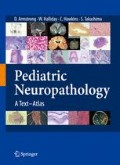Abstract
Tuberous sclerosis (TS) is a dominantly inherited disorder that affects multiple organ systems [1]–[3]. The current diagnostic criteria require TS complex-associated lesions of two or more organ systems or two dissimilar lesions of the same organ system. TS is sporadic in 60%–70% of cases. Two genes have been identified: TSC1 (hamartin) located at 9q34 and TSC2 (tuberin) located at 16p13.3 [4]. The genes have tumor-suppressing activity, but the pathogenesis of TS is not fully understood.
Access this chapter
Tax calculation will be finalised at checkout
Purchases are for personal use only
Preview
Unable to display preview. Download preview PDF.
7 Neurocutaneous Syndromes
Maria BL, Deidrick KM, Roach ES, Gutmann DH (2004) Tuberous sclerosis complex. J Child Neurol 19:632–642.
Harding BN, Copp AJ (2001) Malformations. In: Graham DI, Lantos PL (eds) Greenfields’ neuropathology, 7th edn, Vol 1. Arnold, London, pp 452–456.
Mizuguchi M, Takashima S (2001) Neuropathology of tuberous sclerosis. Brain Dev 23:508–515.
Mizuguchi M, Kato M, Yamanouchi H, Ikeda K, Takashima S (1997) Loss of tuberin from cerebral tissues with tuberous sclerosis and astrocytoma. Ann Neurol 42:270–272.
Lantos PL, Louis CN, Rosenblum MK, Kleihues (2001) In: Graham DI, Lantos P (eds) Greenfields’ neuropathology, 7th edn, Vol 1. Arnold, London, pp 452–456.
Gutmann DH (2002) Neurofibromin in the brain. J Child Neurol 17:592–601.
Kato M, Mizuguchi M, Hattori S, Nakamura S, Takashima S (1998) Loss of neurofibromin in the leptomeningeal astroglial heterotopia of NF1. Pediatr Neurol 18:227–230.
Thomas-Sohl KA, Vaslow DF, Maria BL (2004) Sturge-Weber syndrome: a review. Pediatr Neurol 30:303–310.
Comi AM, Hunt P, Vawter MP, Pardo CA, Becker KG, Pevsner J (2003) Increased fibronectin expression in Sturge-Weber syndrome fibroblasts and brain tissue. Pediatr Res 53:762–769.
Chun HH, Gatti RA (2004) Ataxia telangiectasia, an evolving phenotype. DNA Repair 3:1187–1196.
Lowe JS, Leigh N (2001) In: Graham DI, Lantos PL (eds) Greenfields’ neuropathology, 7th edn, Vol 2. Arnold, London, pp 364–365.
Oka A, Takashima S (1998) Expression of the ataxia-telangiectasia gene (ATM) product in human cerebellar neurons during development. Neurosci Lett 252:195–198.
Rights and permissions
Copyright information
© 2007 Springer
About this chapter
Cite this chapter
(2007). Neurocutaneous Syndromes. In: Pediatric Neuropathology. Springer, Tokyo. https://doi.org/10.1007/978-4-431-49898-8_7
Download citation
DOI: https://doi.org/10.1007/978-4-431-49898-8_7
Publisher Name: Springer, Tokyo
Print ISBN: 978-4-431-70246-7
Online ISBN: 978-4-431-49898-8
eBook Packages: MedicineMedicine (R0)

